The Talos Principle 2: Road to Elysium review

- 3 Comments
Love, joy, regret: three distinct emotions unlikely to leap to mind when talking about artificial intelligence. But it's these very things that are so deftly and authentically delved into in the three distinct chapters of Croteam's chrome-and-circuits ode to the human spirit, Road to Elysium, the expansion to our 2023 Game of the Year, The Talos Principle 2.
When The Talos Principle 2 made its highly anticipated arrival, it offered a revelatory mix of masterful puzzles, sublime out-of-this-world architecture, and a moving story that felt entirely human, despite the total lack of any flesh-and-blood members of mankind. Instead, the tale was set long after the extinction of our species, with a synthetic society serving as humanity's torchbearers in the pursuit of great new frontiers. As the newly birthed 1K in the utopic city of New Jerusalem, players undertook an epic-scale expedition to solve the disappearance of the city's inscrutable founder, Athena. Along the way, they encountered the mysterious Megastructure, a massive pyramid housing untold secrets and technological marvels, sparking much debate about how exactly these "new humans" should come to grips with the miraculous discoveries uncovered, making scientific progress that would chart the course of civilization for millennia to come.
Road to Elysium does much of what the Road to Gehenna expansion did for the original Talos Principle in 2015: it deepens the lore with a heaping helping of well-crafted new puzzles that considerably amp up the established difficulty to a head-spinning degree. It builds off the existing foundation without adding any new tools to the mix, but it quickly gets a good deal more complicated than the logic underpinning the puzzles of its predecessor. While some of Elysium’s puzzles are quite easy, anyone who thought the base game was too much of a cakewalk will have their wishes thoroughly granted here.

It's also a direct follow-up to where things left off, and as such is almost impossible to get into without discussing the key events preceding it. Heck, even Croteam's own elevator pitch for Road to Elysium on Steam has some huge spoilers for The Talos Principle 2's ending. But the way it builds off past events might not be quite what players expect.
In Talos 2’s base game, a lot of storytelling agency was put right into the player's hands. Conversations were peppered with numerous, frequent choices that would have far-reaching effects – some subtle, and some quite world-shaping. By the end of the game, your actions and statements would determine the leader of New Jerusalem, whether the quasi-magical discoveries from the Megastructure should be used to advance society or abandoned entirely, and, depending on if you tackled the optional, super challenging Golden Gate puzzles, whether the tragic death of Athena's miracle-of-science daughter Miranda could be undone through an even more miraculous resurrection.
Accounting for all these varied possibilities at the onset of Road to Elysium would surely result in an impossible level of narrative complexity, so it’s understandable (though still somewhat disappointing) that this expansion picks a clear lane as canon and does away with all the other possible story branches. It comes as a bit of a surprise, though, considering the original game appeared to weigh all potential choices and endings as equally valid. As someone whose choices lined up precisely with where Road to Elysium goes, this didn’t hurt my experience at all, but for players who went in a different direction, it’ll probably be a little disheartening that Croteam’s follow-up essentially tells them that they did it wrong. Fortunately, this criticism is the only significant stumble in Road to Elysium. I'm pleased to report that everything else is a complete and utter triumph.

What the story now lacks in player agency, it more than makes up in how Road to Elysium plays the narrative cards it’s been dealt. Rather than Road to Gehenna's parallel side-story approach that featured a brand new protagonist who was only tangentially linked to The Talos Principle's base campaign, Road to Elysium gives us three separate adventures filled with familiar faces that collectively serve as a sequel to The Talos Principle 2, albeit probably a noncrucial one if you choose to skip it. But to pass over this expansion would mean missing out on Croteam flexing its creative muscles at the top of its game.
Unlike the civilization-altering quest of the epic original, Road to Elysium is more like a celebratory victory lap – a long epilogue after the day is saved, where our characters can get back to living their best lives. The middle chapter especially has a certain cozy intimacy that just feels right in the wake of all that happened prior, and if you enjoyed the diverse cast of The Talos Principle 2, this DLC serves up a tasteful banquet of great character moments to satisfy returning players without falling victim to too much fanservice.
Each chapter is available from the onset, all existing with their own separate save files. They can be played in any order and feel largely distinct, but there are little narrative touches and bits of character development that carry over between each one, making it clear that they're intended to be played in their default sequence. All told, the three chapters combined easily added up to about twenty hours of gameplay for me, slightly more than half the length of the gargantuan-sized base game.
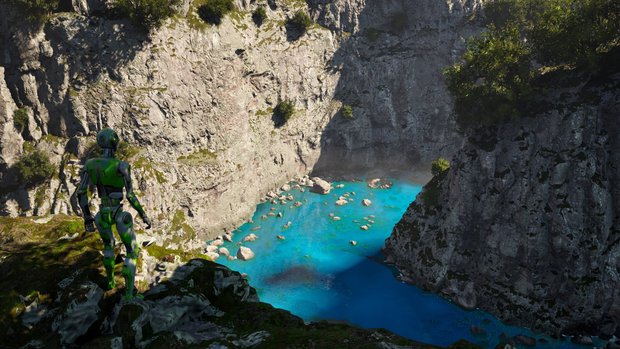
The first chapter, Orpheus Ascending, wastes no time addressing the elephant in the room: what can this DLC's puzzles add to the table if it just uses the same tools as before? It turns out the answer is "quite a lot." The puzzle design here is ingenious, revealing previously unseen layers of the underlying game mechanics that challenged me in totally new ways. It takes the classic "use colored lasers to unlock colored locks" gameplay and tweaks it with extensive use of a technique I'll refer to as “beam breaking.”
With beam breaking, you must set up arrays of lasers to intersect and block each other at key points. When lasers meet, their path is stopped as if they've hit a solid wall. When used properly, this technique allows you to cancel out beams where they're not supposed to go while keeping them active where you need them. Puzzles in this chapter also make use of large, complex chains of opposing colored beams that demonstrate how one type can overpower the other, based on the number of connections between the end of the chain and the laser source, playing out like an elaborate, sci-fi-flavored game of tug of war.
You'll even end up using your own body to interrupt beams and change the entire flow of a laser grid, and there are a couple levels devoid of connectors entirely, where your only way to interact with the pre-existing laser setup is through carefully setting up cubes to block key points and reshape the traffic as needed. These provide far more finite options than before while still managing to be real brain-benders. By the second puzzle, I was already doing wildly new things with laser beams that I never had to attempt in the base game, and before the end of the chapter, my mind was practically reeling from the baffling but fascinating logic behind it all.

Some of the laser arrays in Talos 2 could get fairly complex, but they feel positively quaint compared to the grids you'll arrange here. Previously, your chained lasers would usually have a semblance of linearity; here you'll be rigging up parallel circuits of room-spanning beams where the result looks like the sort of laser-filled insanity you'd expect in an exaggerated high security museum. I was generally able to solve these levels without too much frustration, but one level called Switchboard (which lives up to its name rather fittingly) was so confounding I saw no way to solve it, and gave me little choice but to use one of the collectable level-skipping "sparks" for my first ever time in the series.
I carried on with subsequent levels for a bit, but skipping Switchboard painfully nagged at the back of my mind. Luckily, just like in the base game, you can revisit skipped puzzles and try to solve them again whenever you please. When I eventually did go back and try once more, it seemed that the other puzzles had helped me "level up" my skills, allowing me to finally beat the darn thing in a truly cathartic, near-instant solution. Skipping a level stings, but the feeling of conquering it with a fresh perspective brings twice the satisfaction.
Orpheus Ascending culminates in a very special puzzle featuring an enormous floating laser-filled sphere called the Heart of Anubis that dominates the sky above your starting location. This puzzle is a doozy, making you set lasers at a great distance within a giant dome above you, which initially left me feeling certain I was missing a tool needed to solve it until persistence and some out-of-the-box thinking finally won out.

But it's not all fun and games here. Plot-wise, Orpheus Ascending touches upon the fatal tragedy that struck New Jerusalem’s sister city New Alexandria long in the past, an event only hinted at by a very remorseful Alcatraz in the base game. Using similar techniques to how Miranda was brought back from the beyond, the robots theorize that Sarabhai, a departed resident of New Alexandria whose consciousness is trapped in a digital limbo, can be rescued and given life again in a replacement body. 1K takes on the task in a simulated Egypt-themed environment (a series staple), learning more about Sarabhai through scattered memory fragments and bits of correspondence with her still-living lover Hypatia.
The Talos Principle series has been many things, but never before a love story. The promise of reuniting tragically torn sweethearts was a great motivator to push through all its puzzles, and the writing here is stellar. Each memory fragment you obtain sheds a little more insight into who Sarabhai is and her struggles with finding meaning in life. Love was the missing ingredient that gave her a sense of purpose, while also bringing about hardships of its own. Sarabhai's monologues hit home, particularly her lamentations that as she aged and formed relationships, she discovered there were "so many ways to hurt people" without even trying to.
Orpheus Ascending is a moving and very solid addition to The Talos Principle universe, clocking in at just under four hours in my playthrough, adding some fiendishly difficult challenges that definitely outdo the base game. If this were all the DLC offered, I might have come away from it happy but far from sated. Thankfully, it's only a teensy fraction of what Road to Elysium brings, with the following two chapters totally dwarfing it.
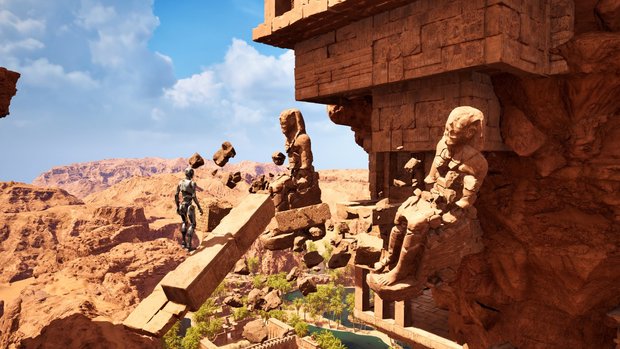
The second chapter, Isle of the Blessed, is where the game really starts to strut its stuff. It's another sequel story, taking place sometime after Orpheus Ascending and letting us catch up with some of my favorite returning characters from Talos 2. In the canon established here, the warmhearted idealist Byron won the election for mayor, and has chosen to embrace the technology of the Megastructure to take robotkind beyond the stars. Meanwhile, Miranda did indeed get saved from her nightmarish purgatory, living a happily-ever-after life with the charmingly optimistic Yaqut. As their relationship evolves, Yaqut and Miranda accompany her parents Athena and Cornelius to a newly opened tropical art exhibit on the titular isle. Several of their close friends are in tow, from Byron to Alcatraz to 1K himself (this time serving as a non-playable character – with quite a surprising twist).
Here you step into the role of the lovable and slightly awkward Yaqut — deeply smitten with Miranda, and with an even deeper hatred of puzzles. But in order to impress his gold-plated girlfriend, you'll have to help him get over his seething prejudice and confront a smorgasbord of challenges in what is easily one of the most beautiful locations in the entire Talos franchise.
Isle of the Blessed is the only chapter of the DLC set in the "real world" rather than simulation-bound constraints, and oh, it's a hell of a looker. It's a picturesque Caribbean-set island that's been converted into a puzzle-lover's haven by the standout new character Barzai (a delightfully cantankerous coot with shades of Willy Wonka), who treats the island as his latest artistic endeavor/vacation resort/theme park. You don't get a ton of time with Barzai, but much like in Orpheus Ascending, you can uncover little tidbits about him from holographic fragments dotted around the environment. He's a terrific character: good humored, more than a little mischievous, and wise, far beyond what his fun-loving antics might suggest. He adds a totally new flavor that was absent from the base game, but slots in so perfectly that he feels like he’s belonged all this time. He’s perhaps my favorite character Croteam has ever made — please bring this guy back for The Talos Principle 3!
Barzai's mission statement of "We solve puzzles because it is joyous, it is beautiful, and it is human" accurately sums up the approach the developers themselves have taken with this chapter. Barzai speaks with reverence about the divine importance of bringing joy to others, no matter how small an act it may be, and here too, the experience is fully about solving puzzles for the sheer pleasure of it. The puzzles are a veritable cornucopia of fun and varied types, and for the first time in the franchise, there are (almost) zero stakes. There's no sinister threat hanging over the peaceful lives of our characters, no malevolent entities yanking the rug out from under you. Everyone seems to be getting along splendidly, and the worst thing that might happen if Yaqut doesn't solve the island's puzzles is some wounded pride.

Being Yaqut offers a very different experience than the voiceless 1K. Even though you're inhabiting a more clearly defined character here, the game still gives you a satisfying amount of choice to shape conversations while honoring Yaqut's established characterization. You're also intimately let in on Yaqut's family dynamics, getting access to shared memorabilia in a group photo album that updates with touching and occasionally silly bits from everyone's idyllic, heartwarming vacation together.
From a storytelling standpoint, Isle of the Blessed is perhaps as good as the series has ever been: funny at the right moments, sentimental and slightly mushy when it ought to be, and poetically moving on a regular basis. The chapter addresses a lingering, bitter loose end from its predecessor with one of the best “apology scenes” I’ve ever seen in a game. It even lets one of the most venomous and dislikable side characters from the past turn over a new leaf, though you’ll only witness this transformation on the in-game social forums.
The characters in this chapter are bliss to interact with – including a fun newcomer with a novel link to the classic entity ELOHIM and a very different, hilarious approach to 1K – but the real draw of Isle of the Blessed is its enormous number of puzzles. In the base game, each zone has eleven puzzles to solve. Isle of the Blessed gives you thirty-four. Croteam could have easily shipped this as its own full-sized DLC and we’d have been none the wiser. The difficulty of these puzzles starts out a fair bit more welcoming than Orpheus Ascending, but slowly ramps up to a level of challenge that once again goes beyond the original game’s.
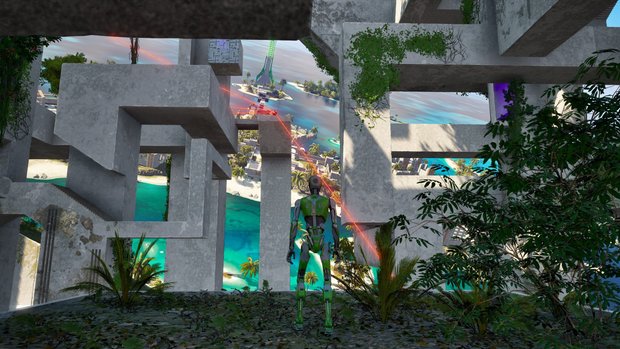
There were several times when I threw up my hands in frustration, wondering if I’d run into a bugged puzzle that needed a patch to be playable, only to return and then crush through it with a new technique. More than once, I caught myself whooping and hollering in victory as I completed a puzzle I previously thought was impossible. Road to Elysium is practically guaranteed to make you pat yourself on the back and feel justified for doing so.
One new feature that debuts in this chapter makes navigation a breeze: a fast-travel option that functions just like the in-game teleporters which occasionally crop up in puzzle rooms. The giant isle is divided into three themed hubs, each with a few junctions that can be instantly warped to from any of the map terminals with nary a load screen. You can't teleport directly to individual puzzles, but you can get plenty close enough to prevent the trek from becoming a slog. It’s a great addition that would have been a lovely inclusion in the base game. It pops up in the final chapter as well, but for some reason is absent from Orpheus Ascending, despite a fairly large map.
The Isle of the Blessed has one heck of a centerpiece once the enormous and multileveled Hexahedron unlocks. This tilted, mazelike cubic tower in the middle of the island is BIG, even by the standards the series is known for. Adding to the sense of scale are its intricate, multipurpose staircases and mindboggling gravity-shifting mechanics that give the whole thing a sense of navigating an MC Escher painting, and it provides many of the game's most gorgeous vistas. The Hexahedron is so massive that, in a series first, the process of navigating it is divided into checkpoint-based subsections, so that if you take a wrong step and fall all the way down, you can jump right back to where you last made significant progress rather than having to climb all the way back up.

Thankfully, despite its colossal scale (which somehow feels even bigger on the inside than it looks from outside), the Hexahedron isn't nearly as daunting to explore as I feared. Its challenge falls well within the difficulty range of many preceding puzzles, making it less about getting endlessly stuck and more about the thrill of joyfully pushing forward. It’ll still take a while to traverse, but its segmented nature gives it an encouraging sense of progression, which makes advancing through the puzzles feel rewarding.
After solving this, it’s time to tackle the Isle of the Blessed's Golden Gates. Like the base Talos 2, the Golden Gate puzzles can only be accessed once all other puzzles are solved. They’re fully optional for reaching the ending, and boy, they’re real humdingers. Some aren’t as brutally hard as others, but getting through them all is supremely satisfying and worth the pain. They're masterfully designed challenges that had me fully invested in untangling their logic, and I came out of the chapter feeling smarter than I did going in.
The only slight letdown of this chapter’s conclusion? Solving every puzzle doesn't really "do" anything. Barzai tells you upfront that the island is intentionally purposeless, and that there is a sort of pure, divine beauty in the "non-necessary," but I still would have loved for there to be a little more acknowledgement from Yaqut and other characters that I’d accomplished all there was to do. I didn’t see any new conversation options unlock with the characters stationed around the island, so whether you do it all or just the required puzzles, you get the same (very touching) ending. But this is a very small nitpick in an otherwise extraordinary chapter, which took me just under ten hours to complete... by far the most substantial zone in any of the games.
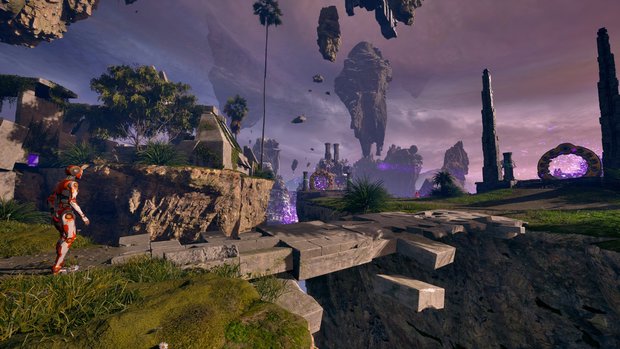
And that's not all!
Into the Abyss is the final chapter, and due to its whopping level of difficulty, it’s best saved for last. While it opens with a scene that's clearly set after the events of Isle of the Blessed, we quickly go into a flashback of one of the key setpieces from The Talos Principle 2, where we see what happens when Byron gets trapped inside the Megastructure – but this time, from his point of view. Stuck in a dreamlike state within the confines of Athena's subconscious, Byron is guided by the voice of the enigmatic ELOHIM to solve at least eight of its twenty-four puzzles to send out a distress signal to his friends and make an escape.
Whatever feelings of superintelligence I was tricked into thinking I'd gained by the end of Isle of the Blessed quickly vanished as I faced the absolute hardest puzzles of the series. By far. For those who complained Talos 2 lacked the challenge offered by the first game's Road to Gehenna expansion, Into the Abyss answers with a bloody vengeance. The very first puzzle was as hard (or harder) than the Golden Gate puzzles I'd encountered in past chapters, and the ones that immediately followed made devious use of minimalist layouts to deceive me into thinking the solutions would be far, far, far more clear-cut than they were.
In keeping with the crushing difficulty, the storyline here gets rather heavy, too. While trapped in Athena's mind, Byron can uncover fragments of her past to hear snippets of very heated (and totally imagined) conversations with the colleagues and family she was closest with. Rather than being real confrontations, they’re just her own subconscious going into overdrive with negative thinking, picking at her own mental wounds in truly merciless fashion, from a fictional version of Byron raging at her for failing everyone to a ghostly Miranda blaming her for her accidental death.

These moments are tremendously effective gut-punches that do a great job reflecting Athena’s anxieties, remorse, and sense of mental collapse, adding new layers of character motivation that further explain why she withdrew from New Jerusalem in the first place. It’s heartbreaking stuff – after all the happy, joyous familial bonding of Isle of the Blessed, it's painful to go back in time and experience the polar opposite, even if it is largely imagined in Athena’s tortured mind.
Still, as savage as Athena’s inner demons are, they don’t hold a candle to the ruthless intellectual torment that this puzzle set will inflict on ill-prepared players. These puzzles feel like the sort of thing that devoted modders might whip up in a level editor to punish each other with. They’re blisteringly difficult, and I was immensely thankful that only a third of them (of the player’s choosing) are necessary to complete.
Many times, progress hinges on a delicate balancing act of carefully moving components into just the right spots – a single false move, and the entire setup can completely backfire and lock you into a dead end. In the base game, situations like this were usually addressed by the presence of escape ladders in key areas, allowing you to climb out of traps and keep working. Here it’s much more common to require a hard reset of the puzzle entirely, putting you back to square one, and the complexity of many of these puzzles means it’s not always obvious how to retrace your steps and regain the lost progress. While this may have wasted a bit too much time for my liking (oh, what I’d have done for a quicksave feature!) it’s ultimately not a terribly big drag, and definitely hammers home just how much harder the DLC is. Making players really think cautiously about their strategy before acting on it adds a level of tension that was absent in the game prior to this point. Your own tolerance for this type of stress will determine whether this is a positive or a negative!

Some of these levels took me over an hour to solve, and I still haven’t managed to finish them all. Even now, despite completing the game, a few of Into the Abyss's bonus puzzles still elude me. Given my experience thus far, I fully expect them to take me another week or two of trial and error before I've emerged victorious and exhausted… assuming I can wrap my head around them at all.
But even though some of the puzzles cross the line into “excessively hard,” the preceding chapters do a great job of slowly prepping you for the logic this portion cruelly demands of you. It’s a sadistic set of levels that borders on pure evil, but ultimately, Into the Abyss is still worth the agony. It may be far from the highlight of the expansion for me, but it has a level of difficulty that I had to respect, if not completely enjoy.
One last thing I haven’t touched on yet is the music. Rather than merely recycling the tunes of The Talos Principle 2, Road to Elysium has plenty of excellent new tracks from returning composer Damjan Mravunac. Most of it feels right at home with what we’ve come to expect, but the highlights are the new pieces for Isle of the Blessed. The slightly funky, reggae-infused additions to the score here are terrific fun, answering the question of "What would it sound like if you crossed The Talos Principle with Monkey Island?" to wonderful, memorable effect.
Overall, Road to Elysium is a must-play for fans of the franchise, especially those looking for a little (or much more) extra challenge. Its stories make for a fantastic triptych, and the fact that it adds so much while coming so soon on the heels of the base game is miraculous. There's hope for a bright future with this franchise, and this DLC makes that future feel more tangible than ever. There’s a LOT of discussion in these chapters about what’s on the horizon for New Jerusalem, including some juicy follow-up to a particular cosmic tease for players who collected all the hidden stars in the original game. It's clearly setting the stage for something grand – something that feels bigger than just another DLC, potentially involving space travel.
Final Verdict
Road to Elysium is a phenomenal ride that gave me many precious extra hours in one of my favorite sci-fi worlds. For all the appeal that the intricate gameplay holds, what continues to put this series into the highest echelon of puzzle games is its storytelling and well-reasoned optimism. It’s rare to find sci-fi properties that seek to elicit a sense of hope for humanity, and much rarer still to find ones that actually pull it off. But The Talos Principle series has always shone in this regard, and in Road to Elysium perhaps more brightly than ever. Between the release of Talos 2 and this expansion, the uncertain and worrying impact of AI in the real world has dominated the collective discussion even more. Its world-shaking impact feels imminent, inevitable, and perhaps irreversible… so in light of all that, it’s really, really nice to have a game that mirrors our reality and posits “yes, but what if…” and looks on the brighter side of maybe.
Hot take
Cranking up the difficulty and empathy in equal doses, Road to Elysium threads a needle that most DLC expansions can only hope for. While a few of the challenges edge a bit into overly difficult territory, it’s an extraordinarily well-crafted and generous helping of brilliant puzzles and lovely emotional payoffs. One of the best puzzle games ever just got one of the best expansions around.
Pros
- Brilliant puzzle design frequently outshines the base game’s
- Terrific new characters effortlessly fit into the story and feel like they always belonged
- The Hexahedron is an architectural masterpiece
- Writing and philosophy are just as outstanding as ever, setting the stage for a bold future for the series
Cons
- Ignores many narrative choices possible in the base game
- Some puzzles may be just a bit too fiendish for their own good
Sean played The Talos Principle 2: Road to Elysium review on PC using a review code provided by the game's publisher.


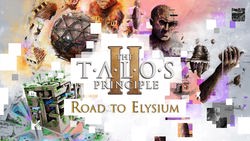
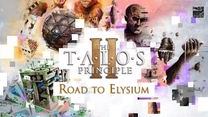









3 Comments
Want to join the discussion? Leave a comment as guest, sign in or register in our forums.
Well written and well thought out- thank you :) I find the leftists overtones in TTP 2 to be overbearing in many cases (preachy and hypocritical), considering it was completely absent in TTP 1, but it’s still an amazing adventure!
Reply
In the first game I was annoyed by how the conversations in the computer gave me deceptive and limited options / made me say things I didn't believe, so I remember skipping out all the philosophical narrative stuff and just getting on with the puzzles. I went away feeling like I'd got through it but didn't care. But that was fine and justified it enough. It's the same here again unfortunately but the mental workout you get from the puzzles is well worth it. I did get a lot of crashes though :(
Reply
Nice review and well written, and I agree with pretty much everything you've said. Croteam really have hit upon a winning formula with the Talos games. After playing the recent Reawakened remaster and its excellent (but extremely tough) new chapter In the Beginning, I'm going to dive back into Talos 2!
Reply
Leave a comment